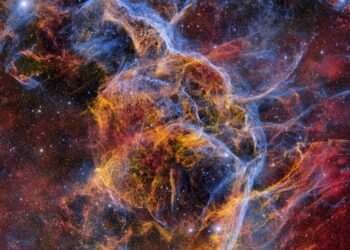
Scientists have used the Dark Energy Spectroscopic Instrument (DESI) to create the most detailed 3D map of the universe so far. The catalog includes over 7.5 million galaxies, more than all other redshift surveys combined. These kinds of maps are essential to unraveling the nature of the universe and its evolution. Particularly, scientists are interested in understanding dark energy, the mysterious force thought to be responsible for the accelerated expansion of the universe.
DESI consists of over 5,000 optical fibers mounted on the Nicholas U. Mayall 4-meter Telescope at Kitt Peak National Observatory in Arizona. These many fibers allow the instrument to capture detailed color spectrum images of millions of galaxies across more than a third of the sky. By breaking down the spectrum of colors, researchers can determine just how much the light has been redshifted — meaning how much it has been stretched toward the red end of the spectrum by the expansion of the universe.
American astronomer Edwin Hubble, after whom the famous Hubble Space Telescope is named, first linked the redshift phenomenon to the expansion of the universe in the 1920s, writing: “This redshift appeared to be larger for faint, presumably further, galaxies. Hence, the farther a galaxy, the faster it is receding from Earth.”
These redshifts allowed DESI to translate a flat observation of the sky into depth, which researchers use to create a 3D map of the universe. DESI has only been online for seven months — just 10% of the way through its five-year mission — but it has already surpassed in size and scope all other similar surveys before it.
By the time the DESI survey is completed, more than 35 million galaxies will have been mapped. The catalog will provide astronomers with copious amounts of data points, an intricate web of complexity that can reveal both the past and future movements of the universe.
“There is a lot of beauty to it,” said Berkeley Lab scientist Julien Guy during a Berkeley Lab-hosted webinar called CosmoPalooza. “In the distribution of the galaxies in the 3D map, there are huge clusters, filaments, and voids. They’re the biggest structures in the universe. But within them, you find an imprint of the very early universe, and the history of its expansion since then.”
“Our science goal is to measure the imprint of waves in the primordial plasma,” he added. “It’s astounding that we can actually detect the effect of these waves billions of years later, and so soon in our survey.”
Nearly 70% of the content of the universe is thought to be made of dark energy, a mysterious form of energy believed to drive the expansion of the universe at an accelerated rate. As the universe expands, more dark energy is created, which causes the universe to expand even faster — a self-perpetuating cycle that drives the expansion of the universe seemingly to infinity.
But can the universe truly expand infinitely? Or will it collapse onto itself in a reverse Big Bang (Big Crunch)? To answer such existential questions scientists need to know how dark energy has behaved in the past, which is where DESI comes in.
Until dark energy is demystified, DESI data can also advance science in other ways. For instance, cosmologists can use DESI’s maps to verify whether Einstein’s theory of general relativity holds over immense spans of space and time. DESI data is also allowing scientists to understand the behavior of intermediate-mass black holes that are otherwise impossible to spot using conventional telescopes. Quasars, some of the brightest and most distant objects in the universe, are also important targets for DESI.
“It’s pretty amazing,” said Ragadeepika Pucha, a graduate student in astronomy at the University of Arizona working on DESI. “DESI will tell us more about the physics of galaxy formation and evolution.”






